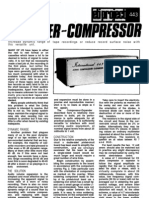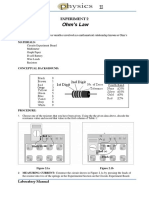Mailing Address: P.O. BOX 21145 Waco, TX 76702 Shipping Address: West Hwy. 6 at Spur 412 Waco, TX 76712 Phone: (254) 848-4435 Fax: (254) 848-4209
Mailing Address: P.O. BOX 21145 Waco, TX 76702 Shipping Address: West Hwy. 6 at Spur 412 Waco, TX 76712 Phone: (254) 848-4435 Fax: (254) 848-4209
Uploaded by
JorgeCopyright:
Available Formats
Mailing Address: P.O. BOX 21145 Waco, TX 76702 Shipping Address: West Hwy. 6 at Spur 412 Waco, TX 76712 Phone: (254) 848-4435 Fax: (254) 848-4209
Mailing Address: P.O. BOX 21145 Waco, TX 76702 Shipping Address: West Hwy. 6 at Spur 412 Waco, TX 76712 Phone: (254) 848-4435 Fax: (254) 848-4209
Uploaded by
JorgeOriginal Description:
Original Title
Copyright
Available Formats
Share this document
Did you find this document useful?
Is this content inappropriate?
Copyright:
Available Formats
Mailing Address: P.O. BOX 21145 Waco, TX 76702 Shipping Address: West Hwy. 6 at Spur 412 Waco, TX 76712 Phone: (254) 848-4435 Fax: (254) 848-4209
Mailing Address: P.O. BOX 21145 Waco, TX 76702 Shipping Address: West Hwy. 6 at Spur 412 Waco, TX 76712 Phone: (254) 848-4435 Fax: (254) 848-4209
Uploaded by
JorgeCopyright:
Available Formats
WP-604
WP-609
WP-612
WP-621
WP-629
WP-639
WP-641
FIELD TUNING INSTRUCTIONS
FOR
4-CAVITY BpBr CIRCUIT DUPLEXER
HIGHLIGHTS
(1)
The duplexer is factory-tuned to the exact frequencies appearing on the decal with use of a
spectrum analyzer/tracking generator and no further tuning or "touching up" is required.
(2)
To maintain maximum isolation, use double-shieled type cable (RG-142 or RG-214) to
connect the duplexer to the transmitter and receiver.
(3)
The duplexer includes interconnecting cables between cavities which are critical in length.
Do not change.
(4)
With some transmitters, the length of the cable between the transmitter chassis and the
duplexer may have to be optimized to obtain a proper impedance match (see instructions).
INSTALLATION
The three input connectors are marked "Low Freq. Input", "High Freq. Input" and "Antenna".
Connect your equipment to the appropriate connector. The frequency is the only concern. All of
the four cavities are built to handle the power output of a transmitter.
EQUIPMENT REQUIRED FOR FIELD ALIGNMENT
The duplexer is factory tuned to the exact operating frequencies prior to shipment from the
factory. No further field tuning or adjustment is normally required. If it becomes necessary to
change the operating frequencies of the duplexer, it can be field tuned if a spectrum analyzer with
a tracking generator is available. In addition a 50 ohm load will be required.
EXPLANATION OF TUNING ADJUSTMENTS
Each section of the duplexer includes two bandpass-reject cavities. The coupling loop of each
bandpass-reject cavity is fixed and can not be adjusted. For proper alignment, each section of the
duplexer must be tuned to two different frequencies: (1) the frequency to be passed and (2) the
frequency to be attenuated or rejected by the filter. Cavities 1 & 2 are always used to pass the
lower of the two frequencies and reject the higher frequency. Cavities 3 & 4 are always used to
Mailing Address: P.O. BOX 21145 Waco, TX 76702
Shipping Address: West Hwy. 6 at Spur 412 Waco, TX 76712
Phone: (254)848-4435 Fax: (254)848-4209 E-mail:wacom@wacomprod.com
pass the higher and reject the lower frequency.
The threaded Invar tuning rod is the "pass" frequency adjustment and the rexolite rod in the stub
is the "reject" frequency adjustment. The reject frequency adjustment must always be the last
adjustment made to each cavity. Adjustment of the stub moves the notch (reject frequency) closer
to, or farther from the pass frequency but does not change the pass frequency alignment.
Rotation of the threaded tuning rod changes alignment of the "pass" frequency as desired, but
also changes alignment of the notch to some undetermined frequency. For this reason, the "pass"
frequency adjustment is made first and the "reject" frequency is made last.
PREPARE THE CAVITIES FOR REALIGNMENT (Pretune)
NOTE: These first six steps are preliminary steps and a high degree of accuracy in the frequency
or amplitude is not required. Even though high accuracy is not needed, these steps are necessary
in order to obtain accuracy in the final steps of tuning the duplexer.
(1)
Connect the equipment as shown in Figure 1. Set the analyzer center
frequency to the lower of the two frequencies and adjust the sweep
setting as to include the full response curve (see Plot 1).
(2)
Loosen the hex nut which locks the threaded tuning rod of the four
cavities and then rotate the threaded tuning rod of cavities 1 & 2 for
minimum loss into the analyzer at the pass frequency.
(3)
Loosen the hose clamps on each of the four stubs so the rexolite rod
can be adjusted (in and out). Leave the clamp slightly tight to
prevent the rexolite rod from sliding out of the stub. Use the rexolite
rods to adjust the notches on cavities 1 & 2 so as to obtain a
symmetrical response about the center frequency as shown in Plot 1.
(4)
Connect the equipment to the duplexer as shown in Figure 2. Set the analyzer to the
higher of the two frequencies.
(5)
Rotate the threaded rods on cavities 3 & 4 for minimum loss into the analyzer at the
pass frequency.
(6)
With analyzer still tuned to the higher frequency, adjust the rexolite
rod of stub on cavities 3 and 4 to obtain a sym-metrical response
about the center frequency as in Plot 1.
The duplexer is now in the proper preliminary state to "fine tune" to the distinct transmit and
receive frequencies.
NOTE: For all "fine tune" steps use horizontal and vertical scales on the analyzer which will yield
highly accurate and reliable frequency and amplitude measurements. Typical response curves are
given in Plots 1-5. The duplex curve (Plot 5) shows the full response of one side of the duplexer.
Mailing Address: P.O. BOX 21145 Waco, TX 76702
Shipping Address: West Hwy. 6 at Spur 412 Waco, TX 76712
Phone: (254)848-4435 Fax: (254)848-4209 E-mail:wacom@wacomprod.com
TUNE "PASS" FREQUENCY OF CAVITIES 3 & 4
(7)
Check the analyzer center frequency to be sure it is still adjusted to the
higher frequency and leave equipment as in Figure 2.
(8)
Rotate the threaded tuning rod of Cavities 3 & 4 for minimum loss at
center frequency into the analyzer. (See Plot 2) Tune one cavity then
the other since there is some interaction between the two cavities.
TUNE "PASS" FREQUENCY OF CAVITIES 1 & 2
(9)
Reconnect the equipment as shown in Figure 1.
(10)
Set the analyzer center frequency to the lower of the two frequencies.
(11)
Rotate the threaded tuning rod of Cavities 1 & 2 for minimum loss at
center frequency into the analyzer. (See Plot 3)
(12)
Tighten the hex nuts which lock the tuning rods of Cavities 1 & 2.
RE-TUNE "PASS" FREQUENCY OF CAVITIES 3 & 4
(13)
Repeat Steps 7 & 8. This is a precautionary step to insure that
Cavities 3 & 4 are properly tuned. Interaction between cavitites can
cause misalignment, particularly if the new "pass" frequency of
Cavities 1 & 2 is close to the old "pass" frequency of Cavities 3 & 4.
(14)
Tighten the hex nuts which lock the tuning rods of Cavities 3 & 4.
TUNE "REJECT" FREQUENCY OF CAVITIES 1 & 2
(15)
Connect the equipment as shown in Figure 3. Terminate the antenna
port with a 50 ohm dummy load.
(16)
Change the vertical scale of the analyzer system to 10 dB per division
and set the center frequency of the analyzer to the higher of the two
duplex frequencies.
(17)
Tune the rexolite stubs on cavities 1 & 2 for maximum rejection at
center frequency. This rejection will be greater than 80 dB so take
appropriate steps to increase the sensitivity/dynamic range of your
analyzer system to accurately tune the rejection notch. (See Plot 4)
Mailing Address: P.O. BOX 21145 Waco, TX 76702
Shipping Address: West Hwy. 6 at Spur 412 Waco, TX 76712
Phone: (254)848-4435 Fax: (254)848-4209 E-mail:wacom@wacomprod.com
(18)
Tighten the clamps of stubs on cavities 1 & 2.
TUNE "REJECT" FREQUENCY OF CAVITIES 3 & 4
(19)
Leave the equipment connected as shown in Figure 3.
(20)
Set the center frequency of the analyzer to the lower of the two duplex
frequencies.
(21)
Tune the rexolite stubs on cavities 3 & 4 for maximum rejection at
center frequency. This rejection will be greater than 80 dB so take
appropriate steps to increase the sensitivity/dynamic range of your
analyzer system to accurately tune the rejection notch. (See Plot 4)
(22)
Tighten the clamps of stubs on cavities 3 & 4.
(23)
The duplexer is now ready for use.
CABLE LENGTH BETWEEN TRANSMITTER AND DUPLEXER
The length of the coaxial cable between the transmitter and the duplexer might be a critical length
with some transmitters because of an impedance mismatch. A mismatch condition can exist
between a transmitter, cavity filter/duplexer, and/or antenna since all of these components can
vary from an absolute impedance of 50 ohms. As an example, a transmitter, or duplexer, or
antenna will probably be listed as having a "nominal" impedance of 50 ohms and a VSWR
(referenced to 50 ohms) of 1.3 to 1 or 1.5 to 1. At a VSWR of 1.5 to 1, the transmitter, or
duplexer, or antenna could have an impedance of anything from 33 ohms to 75 ohms and still be
within specifications. (At 1.3 to 1 VSWR, the impedance can be anything from 38 to 65 ohms).
In a worst-case-scenario, the transmitter might have an actual impedance of 33 ohms, the duplexer
75 ohms and the antenna 33 ohms. As such, system performance will be degraded and yet, all
components will individually meet manufacturers specifications. This impedance mismatch
problem can usually be resolved by "optimizing" the length of coax cable between transmitter and
duplexer and/or by installing one of the impedance-matcher PI Networks available through
Wacom and other sources.
If a transmitter is overly sensitive to a mismatched load impedance, a variety of symptoms might
appear, including one or more of the following:
(1)
The transmitter might generate numerous spurious radiations.
(2)
The transmitter output power might become erratic, either too high or too low as
measured on a wattmeter.
(3)
The insertion loss of the duplexer might measure normal with sweep equipment but
measure too high or too low on a wattmeter when connected to the transmitter.
Mailing Address: P.O. BOX 21145 Waco, TX 76702
Shipping Address: West Hwy. 6 at Spur 412 Waco, TX 76712
Phone: (254)848-4435 Fax: (254)848-4209 E-mail:wacom@wacomprod.com
(4)
The reflected power might change when the length of cable between transmitter and
first cavity is changed.
(5)
Use of a ferrite isolator at output of transmitter solves the forward power and
reflected power problem, and eliminates change in reflected power when length of
cable between the isolator and the first cavity is changed. (In this instance, the
ferrite isolator can be used to reveal the symptoms or as a solution to the problem.)
The above problems might be reduced or minimized by optimizing the length of cable between the
transmitter and first cavity of the duplexer. The optimum length of cable can be found by the
following procedure:
(1)
Tune the transmitter into a 50 ohm dummy load according to the manufacturers
instruction.
(2)
Connect the duplexer to the transmitter. The transmitter output signal should feed
through the wattmeter, then through the duplexer then into a dummy load. If there
is an impedance mismatch the duplexer will detune the transmitter and the cable
length should be optimized.
(3)
Using short lengths of cable (no longer than 1" @ 900 MHz, 2" @ 460 Mhz, 6" @
160 MHz, 24" @ 40 MHz) or right angle elbow connectors, gradually increase the
length of the cable between the transmitter and duplexer until the optimum length
(no detuning effect) is found. Up to four of these short cables should be tried.
(4)
When the proper cable length is determined, i.e., when the system is operating as it
should, replace all of the short and long lengths of cables, right angle elbow
connectors and wattmeter with one continuous length of cable of equivalent
electrical length. Do not overlook the fact that the wattmeter was a part of the cable
length between the transmitter and duplexer during this process. If the wattmeter is
removed from the circuit, the cable length without the wattmeter must be
lengthened by some amount in order to be the same equivalent electrical length as
the cable with the wattmeter in the circuit.
Mailing Address: P.O. BOX 21145 Waco, TX 76702
Shipping Address: West Hwy. 6 at Spur 412 Waco, TX 76712
Phone: (254)848-4435 Fax: (254)848-4209 E-mail:wacom@wacomprod.com
SPECTRUM ANALYZER/TRACKING GENERATOR CONNECTIONS
Figure 1. Hook-up for tuning of low pass.
Figure 2. Hook-up for tuning of high pass.
Mailing Address: P.O. BOX 21145 Waco, TX 76702
Shipping Address: West Hwy. 6 at Spur 412 Waco, TX 76712
Phone: (254)848-4435 Fax: (254)848-4209 E-mail:wacom@wacomprod.com
Figure 3. Tuning of reject notches.
TYPICAL RESPONSE PLOTS
Plot 1. Symmetrical response curve.
Mailing Address: P.O. BOX 21145 Waco, TX 76702
Shipping Address: West Hwy. 6 at Spur 412 Waco, TX 76712
Phone: (254)848-4435 Fax: (254)848-4209 E-mail:wacom@wacomprod.com
Plot 2. High pass response curve.
Plot 3. Low pass response curve.
Plot 4. Low reject response curve.
Plot 5. Duplex curve of low side.
Mailing Address: P.O. BOX 21145 Waco, TX 76702
Shipping Address: West Hwy. 6 at Spur 412 Waco, TX 76712
Phone: (254)848-4435 Fax: (254)848-4209 E-mail:wacom@wacomprod.com
You might also like
- Reciprocating Compressor Condition Monitoring100% (1)Reciprocating Compressor Condition Monitoring7 pages
- Fabrication of Spark Plug Cleaner and Tester-CbiNo ratings yetFabrication of Spark Plug Cleaner and Tester-Cbi26 pages
- OFO Installation Guidelines For ADSS Cables V6 PDFNo ratings yetOFO Installation Guidelines For ADSS Cables V6 PDF27 pages
- Installation, Wiring, Operation Manua: One and Two Pen Circular Chart RecorderNo ratings yetInstallation, Wiring, Operation Manua: One and Two Pen Circular Chart Recorder32 pages
- Kotron Model 811 RF Point Level Switch: DescriptionNo ratings yetKotron Model 811 RF Point Level Switch: Description8 pages
- Lecture Notes On PLCC at MSETCL RTC Padghe Batch 7 (DT 12.7.13)100% (1)Lecture Notes On PLCC at MSETCL RTC Padghe Batch 7 (DT 12.7.13)60 pages
- 4 Channel Programmable FM Remote ControlNo ratings yet4 Channel Programmable FM Remote Control16 pages
- 900 MHZ Digital Spread Spectrum Transceiver: FeaturesNo ratings yet900 MHZ Digital Spread Spectrum Transceiver: Features13 pages
- Manual de Usuario Medidor de Resistencia Analógico Miller 400 - IngNo ratings yetManual de Usuario Medidor de Resistencia Analógico Miller 400 - Ing17 pages
- VHF Transceivers: S-14319XZ-C1 Feb. 2007No ratings yetVHF Transceivers: S-14319XZ-C1 Feb. 200736 pages
- Assembly Manual For: Rev. A May 24, 2015 Written by CRKITSNo ratings yetAssembly Manual For: Rev. A May 24, 2015 Written by CRKITS4 pages
- Tektronix Cookbook of Standard Audio TestsNo ratings yetTektronix Cookbook of Standard Audio Tests24 pages
- Antenna Analyzer vk5jst Version 1 Instructions PDF100% (1)Antenna Analyzer vk5jst Version 1 Instructions PDF10 pages
- DB 4055 56 67 68 71 72 Duplexers InstructionsNo ratings yetDB 4055 56 67 68 71 72 Duplexers Instructions2 pages
- EMC Testing of Copper Cables For High Speed Data TransmissionNo ratings yetEMC Testing of Copper Cables For High Speed Data Transmission30 pages
- General Radio Company: Operating Instructions FOR TYPE 615 A Heterodyne Frequency MeterNo ratings yetGeneral Radio Company: Operating Instructions FOR TYPE 615 A Heterodyne Frequency Meter19 pages
- Digital Coriolis Mass Flowmeters Installation Guidelines and Quick Start - HARTNo ratings yetDigital Coriolis Mass Flowmeters Installation Guidelines and Quick Start - HART12 pages
- Transformer Diagnostic Testing Response: FrequencyNo ratings yetTransformer Diagnostic Testing Response: Frequency10 pages
- VHF Marine Transceiver: Downloaded From Manuals Search EngineNo ratings yetVHF Marine Transceiver: Downloaded From Manuals Search Engine7 pages
- The RC Link and ASK Environment: RF Based Wireless Remote Control SystemNo ratings yetThe RC Link and ASK Environment: RF Based Wireless Remote Control System9 pages
- Continental Electronics: 816R Series FM Transmitters Pre-Installation GuideNo ratings yetContinental Electronics: 816R Series FM Transmitters Pre-Installation Guide17 pages
- Reference Guide To Useful Electronic Circuits And Circuit Design Techniques - Part 2From EverandReference Guide To Useful Electronic Circuits And Circuit Design Techniques - Part 2No ratings yet
- DR B R Ambedkar National Institute of Technology, Jalandhar CEPC-207, Strength of Materials End Semester Examination, Dec 2020No ratings yetDR B R Ambedkar National Institute of Technology, Jalandhar CEPC-207, Strength of Materials End Semester Examination, Dec 20204 pages
- Static and Dynamic Analysis in Design of Exoskeleton StructureNo ratings yetStatic and Dynamic Analysis in Design of Exoskeleton Structure7 pages
- Springfield Interchange Improvement Project50% (2)Springfield Interchange Improvement Project21 pages
- Philippine Agricultural Engineering Standard Paes 119: 2001 Agricultural Machinery - Four-Wheel Tractor - Methods of TestNo ratings yetPhilippine Agricultural Engineering Standard Paes 119: 2001 Agricultural Machinery - Four-Wheel Tractor - Methods of Test35 pages
- Final Year Draft Project Proposal Form: Grid Synchronisation Fail Detection On Sensing Frequency or Voltage Beyond RangeNo ratings yetFinal Year Draft Project Proposal Form: Grid Synchronisation Fail Detection On Sensing Frequency or Voltage Beyond Range2 pages
- Control4® 4-Zone Amplifier and 8-Zone AmplifierNo ratings yetControl4® 4-Zone Amplifier and 8-Zone Amplifier4 pages
- OFO Installation Guidelines For ADSS Cables V6 PDFOFO Installation Guidelines For ADSS Cables V6 PDF
- Installation, Wiring, Operation Manua: One and Two Pen Circular Chart RecorderInstallation, Wiring, Operation Manua: One and Two Pen Circular Chart Recorder
- Kotron Model 811 RF Point Level Switch: DescriptionKotron Model 811 RF Point Level Switch: Description
- Lecture Notes On PLCC at MSETCL RTC Padghe Batch 7 (DT 12.7.13)Lecture Notes On PLCC at MSETCL RTC Padghe Batch 7 (DT 12.7.13)
- 900 MHZ Digital Spread Spectrum Transceiver: Features900 MHZ Digital Spread Spectrum Transceiver: Features
- Manual de Usuario Medidor de Resistencia Analógico Miller 400 - IngManual de Usuario Medidor de Resistencia Analógico Miller 400 - Ing
- Assembly Manual For: Rev. A May 24, 2015 Written by CRKITSAssembly Manual For: Rev. A May 24, 2015 Written by CRKITS
- Antenna Analyzer vk5jst Version 1 Instructions PDFAntenna Analyzer vk5jst Version 1 Instructions PDF
- EMC Testing of Copper Cables For High Speed Data TransmissionEMC Testing of Copper Cables For High Speed Data Transmission
- General Radio Company: Operating Instructions FOR TYPE 615 A Heterodyne Frequency MeterGeneral Radio Company: Operating Instructions FOR TYPE 615 A Heterodyne Frequency Meter
- Digital Coriolis Mass Flowmeters Installation Guidelines and Quick Start - HARTDigital Coriolis Mass Flowmeters Installation Guidelines and Quick Start - HART
- Transformer Diagnostic Testing Response: FrequencyTransformer Diagnostic Testing Response: Frequency
- VHF Marine Transceiver: Downloaded From Manuals Search EngineVHF Marine Transceiver: Downloaded From Manuals Search Engine
- The RC Link and ASK Environment: RF Based Wireless Remote Control SystemThe RC Link and ASK Environment: RF Based Wireless Remote Control System
- Continental Electronics: 816R Series FM Transmitters Pre-Installation GuideContinental Electronics: 816R Series FM Transmitters Pre-Installation Guide
- Reference Guide To Useful Electronic Circuits And Circuit Design Techniques - Part 2From EverandReference Guide To Useful Electronic Circuits And Circuit Design Techniques - Part 2
- Analog Dialogue, Volume 45, Number 4: Analog Dialogue, #4From EverandAnalog Dialogue, Volume 45, Number 4: Analog Dialogue, #4
- Analog Dialogue, Volume 45, Number 3: Analog Dialogue, #3From EverandAnalog Dialogue, Volume 45, Number 3: Analog Dialogue, #3
- Analog Dialogue, Volume 48, Number 1: Analog Dialogue, #13From EverandAnalog Dialogue, Volume 48, Number 1: Analog Dialogue, #13
- Learn Amateur Radio Electronics on Your SmartphoneFrom EverandLearn Amateur Radio Electronics on Your Smartphone
- Analog Dialogue, Volume 46, Number 4: Analog Dialogue, #8From EverandAnalog Dialogue, Volume 46, Number 4: Analog Dialogue, #8
- DR B R Ambedkar National Institute of Technology, Jalandhar CEPC-207, Strength of Materials End Semester Examination, Dec 2020DR B R Ambedkar National Institute of Technology, Jalandhar CEPC-207, Strength of Materials End Semester Examination, Dec 2020
- Static and Dynamic Analysis in Design of Exoskeleton StructureStatic and Dynamic Analysis in Design of Exoskeleton Structure
- Philippine Agricultural Engineering Standard Paes 119: 2001 Agricultural Machinery - Four-Wheel Tractor - Methods of TestPhilippine Agricultural Engineering Standard Paes 119: 2001 Agricultural Machinery - Four-Wheel Tractor - Methods of Test
- Final Year Draft Project Proposal Form: Grid Synchronisation Fail Detection On Sensing Frequency or Voltage Beyond RangeFinal Year Draft Project Proposal Form: Grid Synchronisation Fail Detection On Sensing Frequency or Voltage Beyond Range

























































































